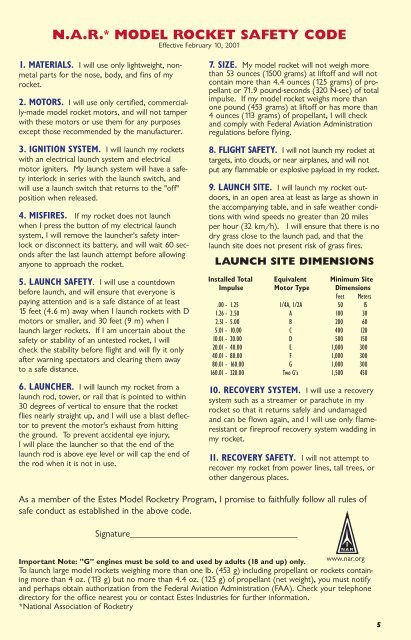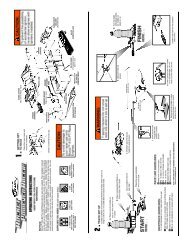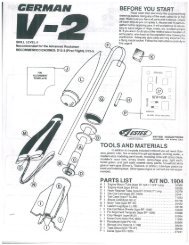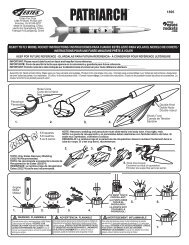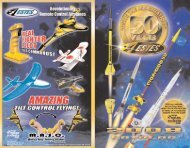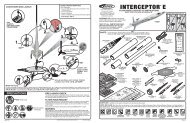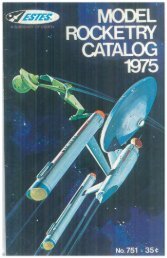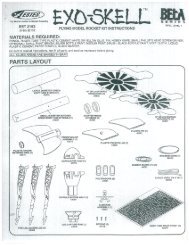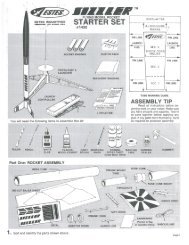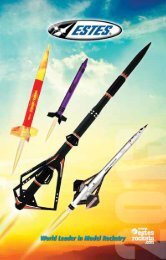Estes 2006 Catalog - Estes Rockets
Estes 2006 Catalog - Estes Rockets
Estes 2006 Catalog - Estes Rockets
Create successful ePaper yourself
Turn your PDF publications into a flip-book with our unique Google optimized e-Paper software.
N.A.R. * MODEL ROCKET SAFETY CODE<br />
Effective February 10, 2001<br />
1. MATERIALS. I will use only lightweight, nonmetal<br />
parts for the nose, body, and fins of my<br />
rocket.<br />
2. MOTORS. I will use only certified, commercially-made<br />
model rocket motors, and will not tamper<br />
with these motors or use them for any purposes<br />
except those recommended by the manufacturer.<br />
3. IGNITION SYSTEM. I will launch my rockets<br />
with an electrical launch system and electrical<br />
motor igniters. My launch system will have a safety<br />
interlock in series with the launch switch, and<br />
will use a launch switch that returns to the "off"<br />
position when released.<br />
4. MISFIRES. If my rocket does not launch<br />
when I press the button of my electrical launch<br />
system, I will remove the launcher's safety interlock<br />
or disconnect its battery, and will wait 60 seconds<br />
after the last launch attempt before allowing<br />
anyone to approach the rocket.<br />
5. LAUNCH SAFETY. I will use a countdown<br />
before launch, and will ensure that everyone is<br />
paying attention and is a safe distance of at least<br />
15 feet (4.6 m) away when I launch rockets with D<br />
motors or smaller, and 30 feet (9 m) when I<br />
launch larger rockets. If I am uncertain about the<br />
safety or stability of an untested rocket, I will<br />
check the stability before flight and will fly it only<br />
after warning spectators and clearing them away<br />
to a safe distance.<br />
6. LAUNCHER. I will launch my rocket from a<br />
launch rod, tower, or rail that is pointed to within<br />
30 degrees of vertical to ensure that the rocket<br />
flies nearly straight up, and I will use a blast deflector<br />
to prevent the motor's exhaust from hitting<br />
the ground. To prevent accidental eye injury,<br />
I will place the launcher so that the end of the<br />
launch rod is above eye level or will cap the end of<br />
the rod when it is not in use.<br />
7. SIZE. My model rocket will not weigh more<br />
than 53 ounces (1500 grams) at liftoff and will not<br />
contain more than 4.4 ounces (125 grams) of propellant<br />
or 71.9 pound-seconds (320 N-sec) of total<br />
impulse. If my model rocket weighs more than<br />
one pound (453 grams) at liftoff or has more than<br />
4 ounces (113 grams) of propellant, I will check<br />
and comply with Federal Aviation Administration<br />
regulations before flying.<br />
8. FLIGHT SAFETY. I will not launch my rocket at<br />
targets, into clouds, or near airplanes, and will not<br />
put any flammable or explosive payload in my rocket.<br />
9. LAUNCH SITE. I will launch my rocket outdoors,<br />
in an open area at least as large as shown in<br />
the accompanying table, and in safe weather conditions<br />
with wind speeds no greater than 20 miles<br />
per hour (32 km/h). I will ensure that there is no<br />
dry grass close to the launch pad, and that the<br />
launch site does not present risk of grass fires.<br />
LAUNCH SITE DIMENSIONS<br />
Installed Total Equivalent Minimum Site<br />
Impulse Motor Type Dimensions<br />
Feet Meters<br />
.00 - 1.25 1/4A, 1/2A 50 15<br />
1.26 - 2.50 A 100 30<br />
2.51 - 5.00 B 200 60<br />
5.01 - 10.00 C 400 120<br />
10.01 - 20.00 D 500 150<br />
20.01 - 40.00 E 1,000 300<br />
40.01 - 80.00 F 1,000 300<br />
80.01 - 160.00 G 1,000 300<br />
160.01 - 320.00 Two G’s 1,500 450<br />
10. RECOVERY SYSTEM. I will use a recovery<br />
system such as a streamer or parachute in my<br />
rocket so that it returns safely and undamaged<br />
and can be flown again, and I will use only flameresistant<br />
or fireproof recovery system wadding in<br />
my rocket.<br />
11. RECOVERY SAFETY. I will not attempt to<br />
recover my rocket from power lines, tall trees, or<br />
other dangerous places.<br />
As a member of the <strong>Estes</strong> Model Rocketry Program, I promise to faithfully follow all rules of<br />
safe conduct as established in the above code.<br />
Signature___________________________________<br />
Important Note: ”G” engines must be sold to and used by adults (18 and up) only.<br />
www.nar.org<br />
To launch large model rockets weighing more than one lb. (453 g) including propellant or rockets containing<br />
more than 4 oz. (113 g) but no more than 4.4 oz. (125 g) of propellant (net weight), you must notify<br />
and perhaps obtain authorization from the Federal Aviation Administration (FAA). Check your telephone<br />
directory for the office nearest you or contact <strong>Estes</strong> Industries for further information.<br />
*National Association of Rocketry<br />
5


